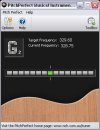Tuning a Guitar
At first, tuning a guitar can seem frustrating, but it won't be if you just follow the first method below on how to tune your guitar and it will be in tune faster than you imagined.
Alternatively, scroll down and choose any other method which suits you.
Method 1. Tuning a Guitar with an Online Tuner
Each button on the tuner represents a guitar string from low to high. The lower is the widest string on your guitar is called the low E string, the next strings are the A, D, G, B and high E.

Click the first "e" button on the left side of the tuner, and play the open low E string on your guitar.
Now adjust the tuning machine that belongs to this string, by turning its peg up or down until the pitch is the same.

When you have finished with the low E string, press the "a" button on the tuner, switch to the next A string and repeat the process again.
Do the same thing with the rest of the strings - the D, G, B and high E, tuning them to the corresponding tones of the d, g, b, and e button on the virtual tuner.
You can quickly return to this article and use the online guitar tuner anytime by clicking "Tuning" button on the left navbar.
My personal tuning tip that you won't find everywhere:
Often when you're turning the peg down, the string will slightly stick at the nut, and when you're playing, the string will accidentally slide through the nut to the normal position, releasing the strain, so the pitch will go down out of tune.
In order to prevent this, bend the string as I did in the video below each time after you turned the peg down, and check the pitch again.
After you finished the tuning, jump to the 'Getting the Right Sound' article, where I explain how to get a decent guitar tone that will impress your pals.
Method 2.
Tuning a Guitar with a Chromatic Tuner

If you don't have an electronic chromatic tuner you
can obtain a virtual tuner for free.
Click here to learn how to download free chromatic tuner software.
Or buy an inexpensive stand-alone guitar tuner for about 20$ in any music store.
Note that any guitar multi-effects processor has a built in chromatic tuner these days. If you have the effect processor, follow the manual on 'how to switch to the tuner mode'.
Tuning a guitar with a chromatic tuner is very easy.
Once you have plugged the electric guitar into the device (or use a built in microphone whenever you're tuning an acoustic guitar).
• If you feel that the string is slightly out of tune, do following:
stroke it and watch the tuner's scale.
If the mark is on the left side, you need to turn the peg up, if it's on the right side, turn the peg down. The center is the correct pitch.
• When the string is completely out of tune, you'll need to do an extra step.
Let's say you tune the G string.
When you stroke the string, the tuner should indicate the note around which your current pitch is. (In the video example below it's around the note of C.)
First, roughly adjust the tuning machine until it indicates the desirable G note. You'll go through the notes of D, E, F and land on G.
After that, begin with precise tuning, checking with the underlying pitch scale, as I described above.
Sorry that the video turned to be a little angled :)
Note:
Although a chromatic tuner is a great help, don't switch your intuition and ears off. If the string you're tuning is very tight but the tuner shows you that the pitch is low - something is wrong. Perhaps you already passed the necessary note the string should be tuned to, so now you tune to the note located an octave higher. This could break the string, so you should loosen it and begin the tuning process again.
A couple of frequent reasons when a tuner may show you a wrong pitch:
• The volume on the guitar is too low or off.
• You plugged an effect between the tuner and the guitar, and the modified guitar sound can't be recognized by the tuner.
Plug your guitar directly into the tuner, or use the bypass mode on the in-between effect unit.

Here is how correctly tuned strings sound like:
high E > B > G > D > A > low EMethod 3. Tuning a Guitar from String to String
This method is especially useful on a trip, when the first two methods are unavailable.
You'll only need any source of a genuine note of low E to tune the rest of the strings up, one from each other.
Here we'll use the pre-recorded audio file
Click here to download the ogg audio file.
Note:
if your device doesn't support the unrestricted, open container format ogg, you can still download the mp3 file
here, although it's not advised, you can learn why at the GNU project website.
Now you'll need to transfer the file to your mobile device.
If your phone doesn't support neither ogg nor mp3, but still plays midi files,
Click here to download a MIDI file instead.
- Get your low E string in tune as we did in the Method 1 above, but for now, compare the pitch with the audio file instead of the online tuner.
- When the low E string is in tune, play it at the fifth fret and tune the nearby open A string to this pitch.
- When the A string is in tune, also play it at the fifth fret and tune the next open D string to that pitch.
- Repeat the same pattern for each of the next strings except the B string. For tuning the B string you'll need to play the G string at the fourth fret instead of the fifth.

You can also use any other musical instrument that is in tune or tuning fork as a genuine source tone.
A few words about the tuning fork:

A Turning fork is a small metal tool that when struck generates a sound, usually of the note of A. This sound has the same pitch as the note played at the fifth fret on the high E string (and not the open low E string, as with the audio file).
That's why tuning a guitar with a tuning fork begins from the high E string towards the lower E.

- First play the high E string at the fifth fret and tune it to the pitch of the tuning fork sound.
- Next tune the B string, playing it at the fifth fret and checking with the open high E string.
- After that, tune the G string, playing it at the fourth fret and checking with the open B string.
- Later, tune the rest of the strings in the same way, playing each tuning string at the fifth fret and checking the pitch with the strings already in tune. Look at the diagram above.
It's good practice to check your guitar's tuning before playing, or anytime you hear that a string is out of tune.
Playing a guitar that's out of tune will not only sound wrong, no matter how good you play, but as I read in one guitar instruction book, it also can cause a damaging effect on your ear for music.
About tuning a guitar with a locking vibrato system
Go to Getting the Right Sound Tutorial
